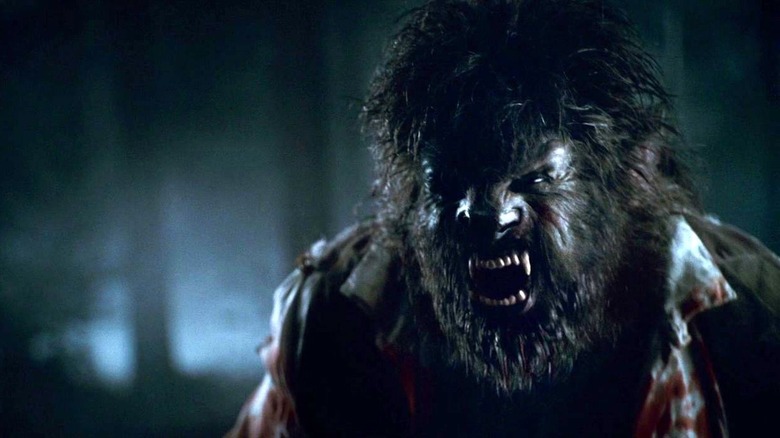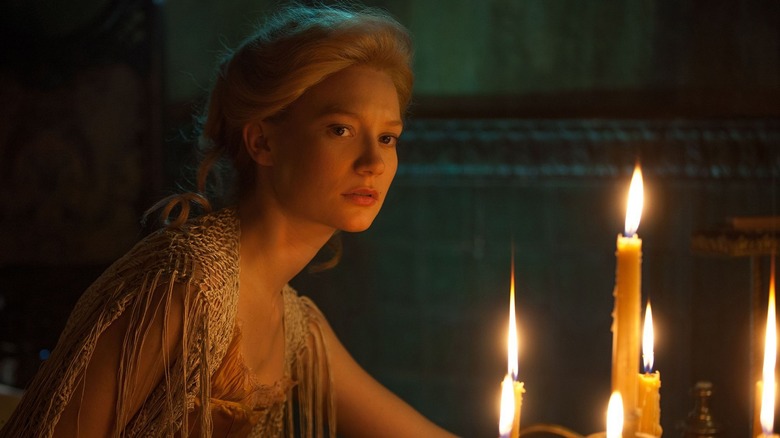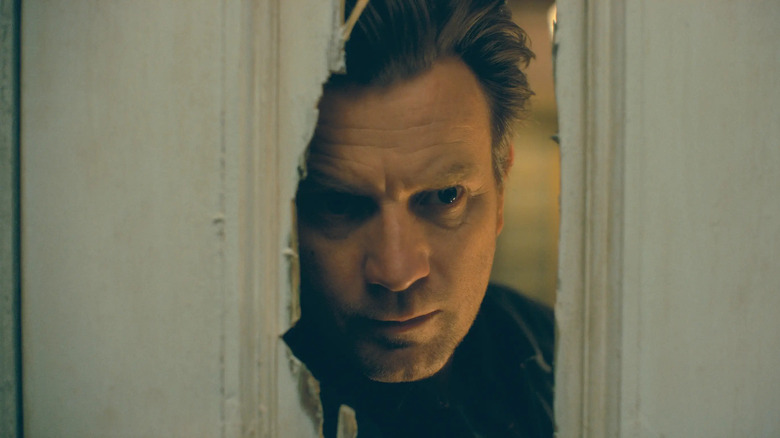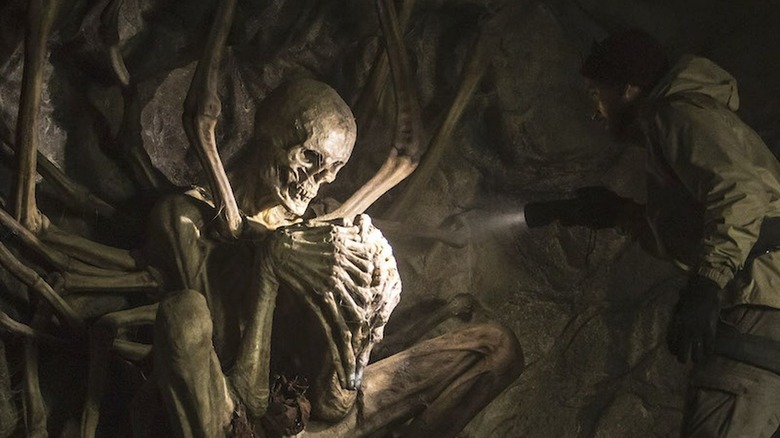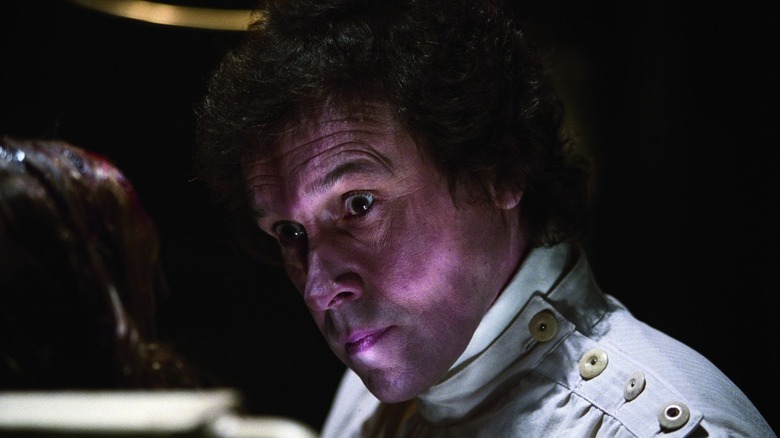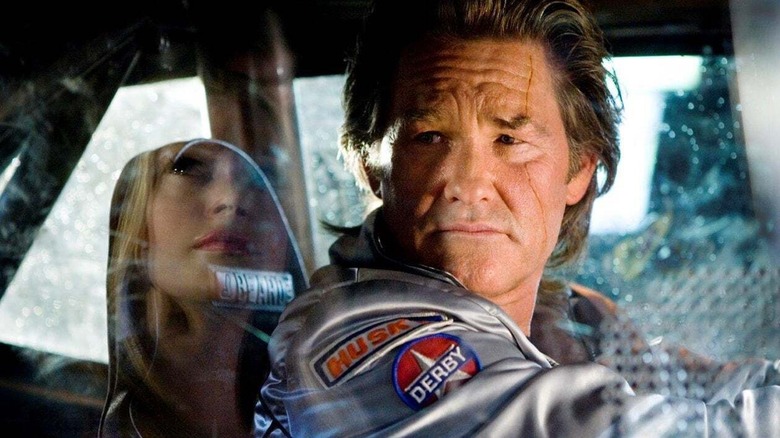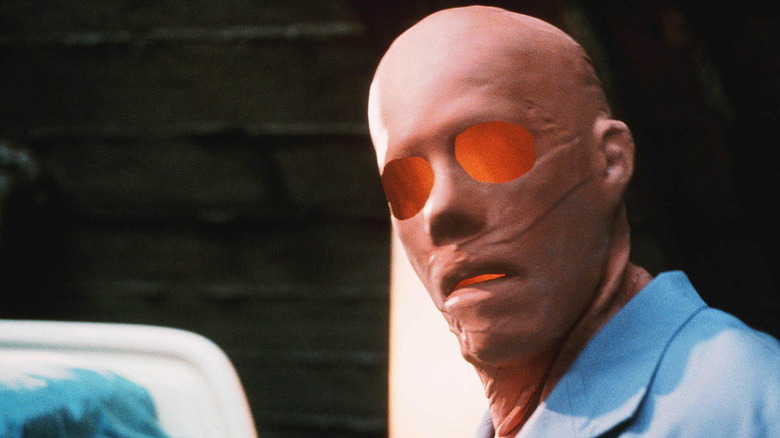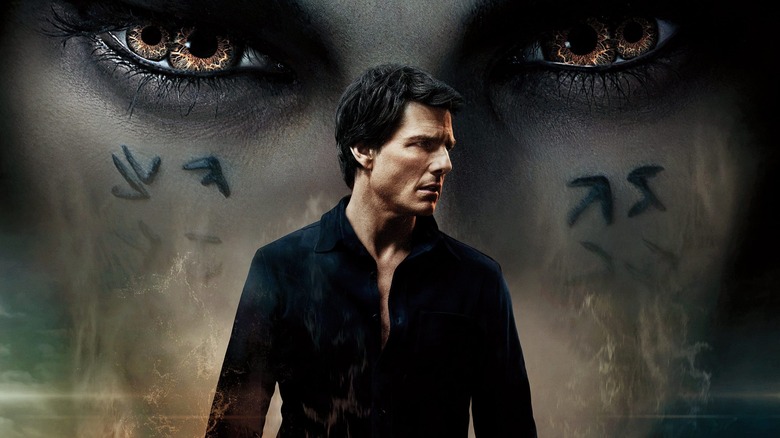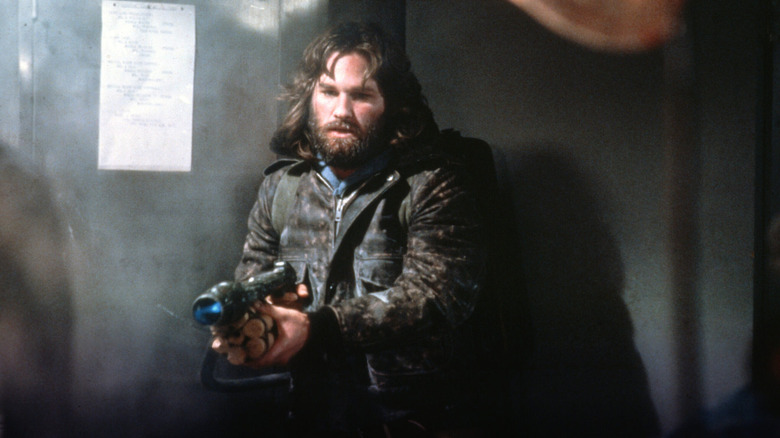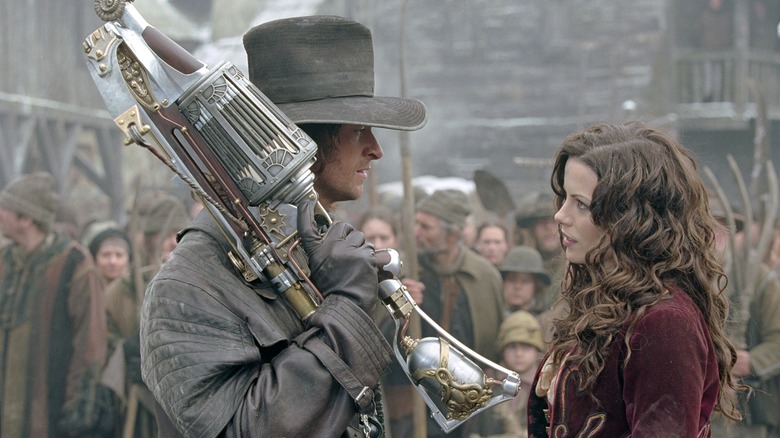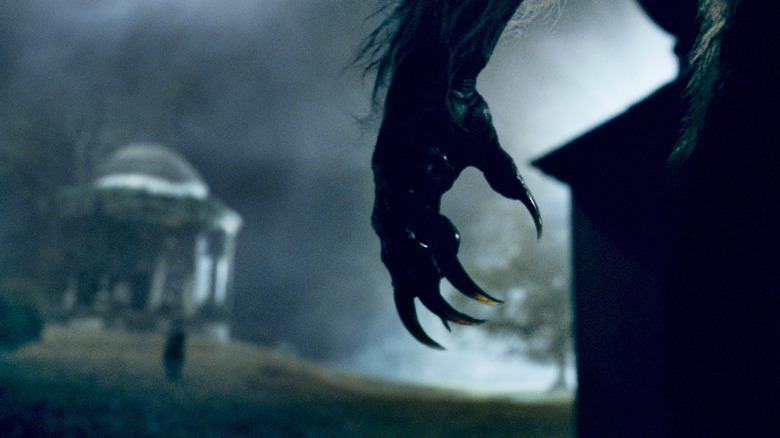Big Budget Horror Movies That Absolutely Flopped (Even Though Some Were Good)
Horror cinema is the domain of the low budget. Universal Studios built blockbusters out of B-movies with releases like "Frankenstein" and "Dracula." Filmmakers like John Carpenter and George Romero became legends after rubbing pennies together and creating gold. Modern production companies like Blumhouse have built entire business models around making horror movies on such shoestring budgets that they simply have to turn a profit. The result: horror movies are generally seen as small investments with the capability of turning enormous profits if the right cultural nerve is struck.
But what happens when a horror movie costs a bit more than a handful of dimes scraped from the bottom of a studio's budget barrel? What happens when a studio, or a motley crew of independent financiers, assembles a much-larger-than-average pile of cash to make a tale of terror? And what happens when that movie fails to connect at the box office?
If you're hoping for answers to those three questions, you're in luck — the following movies fit that bill. Some are masterpieces. Some are cult classics. Some are rightfully forgotten. And some we wish we could forget. But they all have one thing in common: they're big-budget horror that failed to connect.
Alone in the Dark and Bloodrayne
Uwe Boll has sustained a legacy of releasing box office bombs without repercussions. His obsession with video game adaptations has become a signature, like the critically detested shoot-em-up "House of the Dead." Although, that's not even his mightiest box office failure. Christian Slater's and Tara Reid's star power wasn't enough to save 2005's "Alone in the Dark" from a worldwide whimper of $10 million on a $20 million budget — but we reserve the worst for last. Boll's adaptation of the fantasy vampire franchise "BloodRayne" grossed $3 million worldwide on a — wait for it — $25 million budget. The film was released right after "Alone in the Dark," and yet the German blunderkind has since logged some 22 directorial credits when not taking time to box critics who chastised his creations.
"Alone in the Dark" is a more straightforward case of atrocious reviews dooming a release that Lionsgate inherited after purchasing Artisan Entertainment. "BloodRayne" is a little more complicated given how Boll went into business with supporting cast member Billy Zane, who had just opened the distribution company Romar Entertainment with partner James Schramm. They promised Boll "BloodRayne" would screen in 2,000 theaters, but reports indicate that Romar Entertainment only managed around 985 "s***** screens" (Boll's words) and that a few hundred of those establishments didn't even play the film due to miscommunications with Romar. "BloodRayne" is officially the only botched release for Romar Entertainment because the company closed its doors shortly after.
I'd say Boll got screwed with the slightest empathy if he didn't fund both projects with now-illegal German tax shelter funds. Or use "BloodRayne" screenwriter Guinevere Turner's first draft for production and rewrite at least 80% with the cast during shooting — after cursing out Turner via phone. Luckily, she got the last laugh (out loud, often, during the film's premiere). (Matt Donato)
Crimson Peak
Guillermo Del Toro's 2015 gothic romance "Crimson Peak" is a lush, haunting love story with sumptuous special effects and a killer cast. Those things aren't cheap, of course, and the film had a decent-sized $55 million budget. "Crimson Peak" was marketed as the next great horror film from one of the genre's best minds, but that marketing likely hurt the film instead of helping it. Fans were expecting lots of screams, when instead the movie is a slow-burning story of dread with a few ghosts tossed in for flavor. The film only brought in $31 million in the United States. It went on to make back its budget worldwide, but was a pretty major disappointment overall.
"Crimson Peak" is a phenomenal film that was never going to be a mainstream hit. Mia Wasikowska, Jessica Chastain, Tom Hiddleston, and Charlie Hunnam are all stars with serious drawing power, but most audiences just aren't interested in a Victorian-era horror story that stays true to its roots. "Crimson Peak" feels as if an entire semester of Victorian literature was crammed into its two hour runtime, giving viewers a taste of all the genre has to offer, from Robert Louis Stevenson to Mary Shelley. The central romance is appropriately restrained for much of the movie's runtime, too, something 21st century audiences might not have the patience for.
If "Crimson Peak" had been marketed as a twisted gothic romance instead of a standard horror film, it might have still had poor box office returns, but at least people would have known what they were in for. "Crimson Peak" is Del Toro at his best, and this ghostly tragedy deserves to be treasured. (Danielle Ryan)
A Cure For Wellness
If "A Cure For Wellness" was another knife in the heart for mid-budget studio movies, then at least it made its lavish (for a horror movie) $40 million budget count. Gore Verbinski's hypnotic tale opens in the way that many early horror stories did: with a pale young bureaucrat (Dane DeHaan as Lockhart, a junior executive at a financial firm) sent to a grand old building in a remote location, where dark secrets lurk inside its walls. There he becomes entranced by a girl who is as pale and unhealthy-looking as he is: Mia Goth as Hannah, one of the sanitarium's long-term patients and one of its only patients under the age of 65.
"A Cure For Wellness" is very much the sister film of "Crimson Peak," which was released a couple of years previously. Both are big, indulgent, melodramatic Gothic horror tales with a delightfully nasty edge. Both are woefully underrated. And both bombed at the box office. "A Cure For Wellness" ultimately grossed a mere $26.6 million, well below what it cost to make, never mind the costs of marketing and distribution.
Part of this box office disaster might be attributed to competition in the horror genre from Jordan Peele's "Get Out," which released a week after "A Cure For Wellness" and eventually made a staggering $255 million worldwide. And while it's also true that anticipation for "Get Out" may have eclipsed interest in "A Cure For Wellness," the similar downfall of "Crimson Peak" suggests that general audiences just really weren't in the mood for old-fashioned spooky stories at the time. If you missed out on it, though, "A Cure For Wellness" is well worth a visit. In fact, you may find that you never want to leave...
Doctor Sleep
It may come as no surprise to you that the "Shining" sequel "Doctor Sleep" didn't do so hot at the box office — but the 2019 film has morphed into a widely-liked movie with a strong following. The Mike Flanagan-directed installment — which follows Ewan McGregor as a grown-up Danny Torrence as he recovers from alcoholism and returns to his gift of "shine" — was made on a $45 million budget, but the film only grossed $14 million during its opening weekend. It doubled that gross domestically to $31 million, but only brought in another $40 million worldwide, topping out at $72 million total for its entire theatrical run. Considering how much money was spent on the project, a $27 million return — which, to a normal person, seems like a major win — certainly comes up short in comparison to what producers were undoubtedly hoping to make, especially when you consider marketing costs.
It's clear the team behind the movie was banking on the iconography of "The Shining" to carry the film to the bank, and that folks would be compelled by the story's continuation to recommend to a showing to their friends — but it seems that many were initially put off by the fact that key characters like Jack Nicholson's Jack and Shelley Duvall's Wendy were recast for flashbacks and other pivotal scenes. Because of this, the film failed to shine (pun intended) at the box office, but after "Doctor Sleep" had some time to marinate in the minds of Stephen King and Stanley Kubrick fans alike, it started garnering a following. Now, one would be hard-pressed to find a cinephile who doesn't go to bat for this picture, between the top-notch acting, the expansive extensions to world-building, and the ultimately well-done Kubrickian callbacks. I personally had the same journey with the film, and despite the initial flop, I consider it one of my favorites — and certainly one of the best pure sequels in the horror genre. (Lex Briscuso)
The Empty Man
When it comes to box office flops that are totally unjustified, no recent example feels more fitting than "The Empty Man." A heady, heart-pounding slice of supernatural horror, the film packs ample style and substance throughout its 137-minute runtime, but was just met with too many obstacles to truly thrive. "The Empty Man" is the feature directorial debut of David Prior — who previously directed supplemental documentary shorts for DVD releases of everything from "Panic Room" to "Zodiac" — and the film is based on the graphic novel of the same name by Cullen Bunn. Though the film adaptation was green-lit in 2016 with Prior attached to direct, it would take well over four years before the film hit theaters due to a litany of issues. Set to complete shooting in the early winter months of 2017, the final week of shooting was pushed back due to inclement weather and executive vice president Mark Roybal's departure from 20th Century Fox, who was notably one of "The Empty Man"'s biggest supporters. Shooting finally resumed (and concluded) in the fall of 2017, but the imminent Disney/Fox merger only pushed "The Empty Man" back further.
Unceremoniously released in theaters on October 23, 2020 after one final pandemic-related delay, "The Empty Man" grossed $3 million domestically and $1.2 million internationally, making for a whopping $4.2 million to show for roughly 56 months of work against a $16 million dollar budget. Despite all of this, "The Empty Man" has cemented itself as a horror cult classic, heralded by genre enthusiasts as an inventive, intelligent and incredibly scary gem that couldn't be smacked down — no matter how hard job transitions, media acquisitions, and Covid tried. (Natalia Keogan)
Event Horizon
Paul W.S. Anderson may be popularly associated with the "Resident Evil" franchise, but it's "Event Horizon" that gets the director the most full-throated praise among modern horror fans. That certainly wasn't true when the movie premiered in 1997, however, as the $60 million film took in only $26.6 million at the box office. The cosmic horror tale of a starship that disappears in its maiden voyage and comes back full of hellish mystery, the mind-bending film was lambasted by critics (29% on review aggregator Rotten Tomatoes) and audiences in its day (with a remarkably low D+ CinemaScore), but has since received wider positive reappraisal (now boasting a 61% audience score on RT).
When "Event Horizon" was in production, Paramount's co-produced "Titanic" was running over-schedule and over-budget, and the studio needed to put a film in its summer slot. Enter "Event Horizon." To make the deadline, instead of the DGA-guaranteed 10 weeks of editing, Anderson agreed to six weeks ... which became a rushed, 'round-the-clock four weeks in practice. The resulting 130-minute cut floored test audiences and the studio alike with its rampant violence and bloated runtime. Paramount overcorrected, forcing a 90 minute cut that removed a host of major scenes. The bungled theatrical cut was matched by (in Anderson's words) the studio's choice to market it as a slightly darker "Star Trek," leading audiences to expect remarkably different things from the mind-bending, bloody theatrical release. The film's post-theatrical reappraisal begun almost immediately, with a successful-enough DVD home release (rumors of a restored director's cut never came to fruition — that axed footage is now lost). Ultimately, "Event Horizon" suffered compounding post-production failures alongside mishandled marketing, sabotaging a film ahead of its time whose reputation has vastly improved as the years pass. (Jeff Ewing)
Feardotcom
Dark Castle Entertainment launched in 1999 with the William Malone-directed remake of "The House on Haunted Hill," bringing in over $42 million against a budget of $19 million and debuting at the number one spot on its opening weekend. Regardless of the mixed reviews from critics, William Malone had proven to be a commercial success. His next project was "Feardotcom," billed as a horrific crime thriller following Detective Mike Reilly (Stephen Dorff) who joins forces with Department of Health researcher Terry Huston (Natascha McElhone) to investigate a series of disturbing deaths that seem to all be linked to their previous visiting of Feardotcom.com, a live feed of voyeuristic torture and murder. With a $40 million budget, Academy award-nominated actor Stephen Rea cast as the villain, and a marketing campaign featuring nightmarish imagery of a woman's disfigured face, "Feardotcom" seemed to have everything going for it ...until audiences saw the final product.
"Feardotcom" currently boasts a measly 3% on Rotten Tomatoes and is considered by many fans to be one of the worst horror films ever made. The film debuted at the fifth spot during its opening weekend, but with scathing reviews, poor word of mouth, and competing against the massively successful "Signs" and "My Big Fat Greek Wedding," the tonal mess of "Feardotcom" didn't stand a chance, ultimately earning only $18.9 million worldwide. The financial failure destroyed Malone's budding career, and his final film before calling it quits, "Parasomnia," was only possible because Malone funded the project out of his own pocket. Unlike his remake of "The House on Haunted Hill" which has amassed a cult following over the years, "Feardotcom" still remains one of horror's biggest flops, with little hope for redemption in sight. (BJ Colangelo)
Grindhouse
I still remember seeing Quentin Tarantino and Robert Rodriguez's "Grindhouse" back in 2007 — in an empty theater, around Easter, as a birthday present from my then-girlfriend. The double feature of Tarantino's "Death Proof" and Rodriguez's "Planet Terror" was connected by fake trailers from prominent directors like Edgar Wright and Rob Zombie as an ode to the 1970s exploitation scene. It was the ultimate genre throwback but bombed with mainstream audiences who weren't itching for a three-hour-plus experience loaded with zombie gore and highway dismemberment. On a budget reported by Box Office Mojo as $67 million, "Grindhouse" shamefully limped across the domestic finish line with only $25 million.
Take your pick of reasons why "Grindhouse" failed to gross even half of what some Marvel movies amass opening weekend. A religious holiday break isn't prime real estate for extreme violence and sloppy sleaze flicks. Casual theater patrons aren't willing to endure over-the-top genre titles over two hours, let alone three. Producer Harvey Weinstein was so disheartened by the financial woes of the film's stateside run that he split "Death Proof" and "Planet Terror" for international release — "Death Proof" grossed an additional $30 million while "Planet Terror" added $10 million. I'm a "Planet Terror" fiend myself if we're playing the comparison game, but neither film deserved such dismissal. "Grindhouse" was born from creative passion and against-odds ambition, which keeps outspoken fans of the one-two punch replaying their home release copies. For that reason alone, Tarantino happily stated, "I'm proud of my flop." (Matt Donato)
Hollow Man
After a series of successes with "Total Recall" and "Basic Instinct," filmmaker Paul Verhoeven was hit by a set of critical and box office duds. 1995's lurid "Showgirls" hit $37.8 million on a $40 million budget, while 1997's widely misunderstood "Starship Troopers" landed only $121 million on a budget of $100M. After this row of surprising failures, Verhoeven took a foray into horror with 2000's "Hollow Man," starring Kevin Bacon as a scientist who volunteers to be the test subject of an invisibility serum that drives him murderously mad. The film ended with a profitable but tepid $191.2 million outing on a $90 million budget (and a mere $73.2 million bow in the United States). It hit nowhere near his string of box office home runs, received a notoriously poor critical reception (with an abysmal 28% RT critical score), and remains the first movie in his oeuvre that Verhoeven says he "should not have made." What went wrong?
At their core, I'd describe Paul Verhoeven films at their best as high-concept "id" films, loaded with sex and violence with a fun and intelligent edge. By contrast, "Hollow Man" is a relatively bland and straightforward film, markedly different from the creative, engaging sci-fi outings for which Verhoeven had become known. He stated in later interviews that the film was studio-dominated and admittedly lacked his personal touch. It received such a lukewarm response because it didn't feel like a Paul Verhoeven movie even to the director himself, and audiences could tell! Gone are the intelligent extravagances of his more characteristic films due largely to studio interference, resulting in a film lacking Verhoeven's style that feels comparably forgettable by contrast. (Jeff Ewing)
The Mummy
Only making $80 million domestically on a $125 million budget, the 2017 Tom Cruise vehicle "The Mummy" bombed so severely that it effectively killed a franchise before it could get off the ground. Though most immediately think of the 1999 film starring Brendan Fraser and Rachel Weisz when they think of "The Mummy," the monster itself was part of the first iteration of Universal's horror slate, initially appearing in the 1932 movie also titled "The Mummy." However, with the overwhelming success and audience appeal of franchises like the Marvel Cinematic Universe, Universal thought they'd whip up their own interconnected universe, dubbed the "Dark Universe," with a bloated, action-heavy (and horror-light) "The Mummy" set to kick things off.
Though the film ended up grossing $329 million internationally (with $6.6 million coming from opening night in South Korea alone), the overall box office turnout stopped the would-be Monster Mash well before the party started. Though "The Mummy" teases characters clearly connected to other horror tales — namely Russell Crowe appearing as Dr. Jekyll and Mr. Hyde — there were several other high-profile names preemptively associated with the "Dark Universe," with Javier Bardem saying he'd still love to play Frankenstein's monster. Yet with the success of Leigh Whannel's inventive Universal Monster remake "The Invisible Man," Universal has teamed up with Blumhouse to create low-budget, artistically driven Universal Monster remakes — hopefully producing perceptible box office yields this time. (Natalia Keogan)
Prometheus and Alien: Covenant
There was a palpable excitement in 2012 as "Prometheus" – the movie that saw director Ridley Scott returning to the "Alien" franchise after more than 30 years — was getting ready to hit theaters. But the results left audiences a bit divided, as the actual Xenomorphs, the trademark aliens of the franchise, don't actually appear in the movie. Despite that, it did pretty solid business, grossing $403 million at the global box office (per Box Office Mojo). Fox opted to pursue a sequel with Scott once again in the director's chair.
The script for what would eventually be called "Alien: Covenant" went through several iterations and, as Scott once put it "we were struggling then with the screenplay." Earlier in the film's development, he had referred to it as "Alien: Paradise Lost," but the film's title changed along with the story. In the end, we got a movie that did indeed deliver Xenomorphs with a marketing campaign that leaned heavily on that notion. This was being marketed as a proper "Alien" movie through and through.
Be that as it may, the resulting film did not capture the attention of the masses when it hit theaters in the summer of 2017, taking in just $240 million worldwide against a budget of $97 million, according to Box Office Mojo. While there are certainly more disastrous outcomes financially, this fell well short of expectations and left the theatrical viability of the franchise in question ... which is why we never got a sequel resolving that big cliffhanger, despite the fact that Scott had planned to make one. Audiences may have felt a little burned by "Prometheus" and the lack of must-see reviews from critics didn't help the case for "Covenant," despite the best efforts from Scott and Fox. (Ryan Scott)
The Thing
Given how often it pops up on "Greatest Horror Movies Of All Time" lists, you might be surprised to learn that John Carpenter's "The Thing" was not a box office success upon its initial release, and got some pretty scathing reviews from critics. Made with a budget of $15 million and largely filmed on location in Alaska and British Columbia, "The Thing" landed quietly at the box office. It debuted at #8 in its opening weekend and grossed just $19.6 million at the North American box office by the end of its run (it didn't get a theatrical release overseas).
How could such a now-acclaimed horror movie have performed so poorly? Well, both critics and audiences at the time kind of hated it. "The critics thought the movie was boring and didn't allow for any hope," Carpenter recalled in an interview with Creative Screenwriting. "That was the part they really hammered on." But the director knew in advance that the movie was in trouble when Universal Pictures did test screenings for "The Thing," and the reaction was less than positive. As Carpenter explained:
"There was one young gal who asked, 'Well what happened in the very end? Which one was the Thing, and which one was the good guy?' And I said, 'Well, you have to use your imagination.' And she said, 'Oh, God. I hate that.' ... We were dead. Dead in the water. Dead. Horrible."
Fortunately, things don't always stay dead in the horror genre. Like many '80s horror movies, "The Thing" found its audience in the blossoming market of home media, where avid genre fans enthusiastically shared recommendations for "video nasties." There, the gruesome special effects and ambiguous ending that had alienated general audiences instead became a selling point, and "The Thing" finally thrived. (Hannah Shaw-Williams)
Van Helsing
2004's "Van Helsing" was given a whopping $170 million budget and thanks to a solid performance internationally, managed to bring home over $300 million. While these numbers would typically indicate a sign of success, the dollar amount wasn't high enough to fulfill Universal's plans to reboot their Universal Monsters universe, especially after being met with relentlessly horrible reviews.
Hugh Jackman stars as famed monster slayer Gabriel Van Helsing, who is sent off to Transylvania to defeat Count Dracula. Unfortunately, Kate Beckinsale's Anna Valerious informs him that Dracula has formed an alliance with Dr. Frankenstein's monster, and the duo must team up to defeat them before they can enact a centuries old curse on the Valerious family. Blending the worlds of two of Universal's most prized monsters, as well as appearances by Mr. Hyde and werewolves, felt like a license to print money. But the hype was destroyed when audiences showed up to the theater and were met with an overuse of CGI and Richard Roxburgh's laughably bad accent as Count Dracula. While the heart was clearly in the right place, "Van Helsing" is a chaotic mess of too many ideas thrown together, and not even the charm of Hugh Jackman could save it.
Boasting a 24% on Rotten Tomatoes, "Van Helsing" was so poorly received that it scared off Universal from pursuing their monster-verse, realizing how lucky they were to have turned a profit on such a stinker. As of 2020, master of horror James Wan and "Overlord" director Julius Avery are allegedly working on a reboot of "Van Helsing," yet another attempt by Universal to revamp their cinematic monster universe. Here's hoping this one turns out better than the last. (BJ Colangelo)
Virus
"Virus" sounds like a 1999 horror movie madlib: an invading alien attacks a Russian space station and beams itself aboard a Russian research vessel in the South Pacific, then uses electricity to turn all of the people aboard into cyborg slaves. A tugboat crew composed of Jamie Lee Curtis, Donald Sutherland, and William Baldwin discovers the vessel and sneaks aboard to scavenge any sellable parts. What happens next is pure mayhem. Curtis is a horror household name, and the story is just weird enough to work, so why did "Virus" only make around $30 million worldwide on a $75 million dollar budget?
Sometimes, a bad movie is just a bad movie. "Virus" is a mostly incomprehensible mess that received one of Roger Ebert's most negative reviews of all time. The cinematography and lighting are haphazard, making entire scenes difficult to see. There are also plenty of other, marginally better horror movies set on boats from this era, like "Deep Rising" and "Ghost Ship." Don't just take our word for it. Even Curtis has been outspoken about just how bad "Virus" is, telling IGN in 2003:
"'Virus' is so bad that it's shocking... That would be the all time piece of s***...It's just dreadful... "That's the only good reason to be in bad movies. Then when your friends have [bad] movies you can say 'Ahhhh, I've got the best one.' I'm bringing 'Virus.”"
While some fans over the years have defended "Virus" as a cult classic, the kind that's "so bad it's good," it turns out most folks are in Curtis and Ebert's camp and think this one's just a stinky sinker. (Danielle Ryan)
The Wolfman
Remakes are nothing new in Hollywood, but they can be especially dangerous when tackling a piece of legitimate cinema history. Such was the case with Universal's 2010 remake of "The Wolfman," which starred Benicio Del Toro and Anthony Hopkins in one of the most expensive horror movies ever produced, with a reported production budget of $150 million. The result was also one of the most notable box office disasters of the last 15 years, if not ever, and it all goes back to a messy production that led to a movie that is generally considered to be, well, not-so-great.
Mark Romanek had been scheduled to direct the movie up until the very last minute, but he became embroiled in debates with the studio, in part over the amount of time needed to make the film. Joe Johnston was brought in to handle things and the "Rocketeer" filmmaker found himself in a messy situation as well. As Johnson explained shortly after the film's release, constant script changes kept necessitating reshoots and changes during the editing process. Cuts were made in an attempt to save money that, in the end, ended up costing the studio more money due to necessary reshoots and retooling.
Against a wave of negative reviews, the movie earned a grand total of just $139 million globally, failing even to recoup its budget according to Box Office Mojo. Despite having Oscar-winning visual effects and an A-list cast, the mess behind the scenes ultimately led to financial. The budget got out of hand, and even if the movie was received better critically, it would have been tough for any horror movie to make the kind of money that a $150 million budget requires to be considered a success. Much like the Wolfman himself, this one seemed to be cursed. (Ryan Scott)
